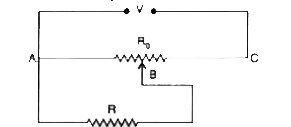Two monochromatic radiations of frequencies v1 and v2 (v1>v2) and having the same intensity are, in turn, incident on a photosensitive surface to cause photoelectric emission. Explain, giving reason, in which case (i) more number of electrons will be emitted and (ii) the maximum kinetic energy of the emitted photoelectrons will be more.Solution in Kannada
(i) Number of electrons emitted depends on intensity of radiation falling on it. Since v1 and v2 frequencies have same intensity, therefore same number of electrons will be emitted by both.
(ii) hv=ϕ0+Kmax
∴ For given ϕ0 (work function of metal)
Kmax increases with v
∴ maximum kinetic energy of emitted photoelectrons will be more for monochromatic light of frequency v1 (as v1>v2).
Topper's Solved these Questions
- DUAL NATURE OF RADIATION AND MATTERBOOK - OSWAAL PUBLICATIONCHAPTER - DUAL NATURE OF RADIATION AND MATTEREXERCISE - TOPIC-1 PHOTOELECTRIC EFFECT (SHORT ANSWER TYPE QUESTIONS-II)
6 Videos
- DUAL NATURE OF RADIATION AND MATTERBOOK - OSWAAL PUBLICATIONCHAPTER - DUAL NATURE OF RADIATION AND MATTEREXERCISE - TOPIC-1 PHOTOELECTRIC EFFECT (LONG ANSWER TYPE QUESTIONS)
4 Videos
- DUAL NATURE OF RADIATION AND MATTERBOOK - OSWAAL PUBLICATIONCHAPTER - DUAL NATURE OF RADIATION AND MATTEREXERCISE - TOPIC-2 DE-BROGLIE RELATION (NUMERICAL PROBLEMS)
7 Videos
- CURRENT ELECTRICITY BOOK - OSWAAL PUBLICATIONCHAPTER - CURRENT ELECTRICITY EXERCISE - TOPIC-3 (POTENTIOMETER & APPLICATIONS) (NUMERICAL PROBLEMS)
2 Videos
- ELECTRIC CHARGES & FIELDSBOOK - OSWAAL PUBLICATIONCHAPTER - ELECTRIC CHARGES & FIELDSEXERCISE - (TOPIC -2)Numerical Problems
5 Videos
Similar Questions
Mention any three properties of a photon.
View SolutionWrite any three experimental observations of photoelectric effect
View SolutionCalculate de-Broglie wavelength associated with a rifle bullet of mass 2 gram moving with a speed of 400ms−1.
View SolutionA resistance of RΩ draws current from a potentiometer. The potentiometer has a total resistance R0Ω.A voltage V is supplied to the potentiometer. Derive an expression for the voltage across R when the sliding contact is in the middle of the potentiometer.

View SolutionAn atom was earlier assumed to be sphere of radius a having a positively charged point nucleus of charge +Ze at its centre . This nucleus was believed to be surrounded by a uniform desity of negative charge that made the atom neutral as a whole.
Use this theorem to find the electric field of this atom at a distance r(r>a) from the centre of the atom.
View SolutionPhotoelectric emission is observed from a metallic surface for frequencies v_(1) and v_(2) of the incident light rays (v_(1) gt v_(2)) . If the maximum values of kinetic energy of the photoelectrons emitted in the two cases are in the ratio of 1 : k , then the threshold frequency of the metallic surface is
View SolutionPhotoelectric emission is observed from a metallic surface for frequencies v1andv2 of the incident light. If the maximum value of kinetic energies of the photoelectrons emitted in the two cases are in the ratio n:1 then the threshold frequency of the metallic surface is
View SolutionPhotoelectric emission is observed from a surface for frequencies v_(1) "and" v_(2) of the incident radiation (v_(1) gt v_(2)) . If maximum kinetic energies of the photo electrons in the two cases are in the ratio 1:K , then the threshold frequency is given by:
View SolutionPhotoelectric emission is observed from a metal surface for frequencies v_(1) and v_(2) incidents radiations (v_(1) gt v_(2)) . If the maximum kinetic energy of the two electrons are in the ratio 1:2 , then how is threshold frequency (v^(@)) experssed.
View SolutionPhotoelectric emission is observed from a surface for frequencies v_(1) and v_(2) of incident radiation (v_(1)gtv_(2)) If max K.E of photoelectrons in two cases are in the ratio 1 : k, then threshold frequency (v_(0)) will be.
View SolutionPhotoelectric emission is observed from a surface for frequencies v_(1) and v_(2) of the incident radiation (v_(1) gtt v_(2)) . If the maximum kinetic energies of the photoelectrons in the two cases are in the ratio 1 : k , what will be the theshold frequency (v_(0)) in term of v_(1), v_(2) and k ?
View SolutionPhotoelectric emission is observed from a metal surface with incident frequencies v_(1) and v_(2) where v_(1) gt v_(2) . If the kinetic energies of the photoelectrons emitted in the two cases are in the ratio 2 : 1 , then the threshold frequency v_(0) of the metal is
View SolutionPhotoelectric emission is observed from a metallic surface for frequenciesv1andv2of the incident light (v1>v2).If the maximum values of kinetic energy of the photoelectrons emitted in the two cases are in the ratio 1:n,then the threshold frequency of the metallic surface is
View SolutionPhotoelectric emission is observed from a metallic surface for frequenciesv1andv2of the incident light rays (v1>v2).If the maximum value of kinetic energy of the photoelectrons emitted in the two cases are in the ratio 1:k,then the threshold frequency of the metallic surface is
View SolutionPhotoelectric emission is observed from a surface for frequencies v_(1) and v_(2) of incident radiations (v_(1) gt v_(2)) . If the maximum kinetic energy of photoelectrons in the two cases are in the ratio of 2 : 1 then threshold frequency v_(0) is given by.
View Solution
